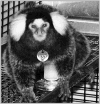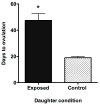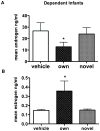Social effects via olfactory sensory stimuli on reproductive function and dysfunction in cooperative breeding marmosets and tamarins
- PMID: 22890774
- PMCID: PMC3502670
- DOI: 10.1002/ajp.22061
Social effects via olfactory sensory stimuli on reproductive function and dysfunction in cooperative breeding marmosets and tamarins
Abstract
Most primates are social species whose reproduction is influenced by their social relationships. The cotton-top tamarin, Saguinus oedipus, and the common marmoset, Callithrix jacchus, are cooperative breeding species where the family structure alters reproductive function in many ways. While primates receive social effects on reproduction via all sensory stimuli, the marmosets and tamarins are particularly influenced by olfactory/chemosensory stimuli. The olfactory sensory processing is the "social glue" that keeps the family together. This review describes a number of studies using the marmosets and tamarins at the University of Wisconsin to demonstrate how odor cues are used for altering reproductive function and dysfunction. Several key studies will be discussed to show the role of odor signaling of the female reproductive state. The suppressive effects of odors are mediated by priming odors and can cause a suppressive influence on ovulation in young females via their mother's scents. Additionally, odor cues from the infant function as priming odors to ensure that fathers and mothers are present and receptive to their parental care duties. Neural pathways occur via the processing of priming odors that consequently stimulate alterations in the behavioral and endocrine response to the stimuli. The dynamics of the cooperative breeding system ensure that offspring have essential needs met and that they develop in a family environment. Olfactory communication plays a key role in maintenance of the social system of Callitrichid monkeys.
© 2012 Wiley Periodicals, Inc.
Figures








Similar articles
-
Comparative analysis of masseter fiber architecture in tree-gouging (Callithrix jacchus) and nongouging (Saguinus oedipus) callitrichids.J Morphol. 2004 Sep;261(3):276-85. doi: 10.1002/jmor.10249. J Morphol. 2004. PMID: 15281057
-
Parental failure in captive common marmosets (Callithrix jacchus): a comparison with tamarins.Folia Primatol (Basel). 2002 Jan-Feb;73(1):46-8. doi: 10.1159/000060418. Folia Primatol (Basel). 2002. PMID: 12065940 No abstract available.
-
Gum feeder as environmental enrichment for zoo marmosets and tamarins.Zoo Biol. 2020 Mar;39(2):73-82. doi: 10.1002/zoo.21531. Epub 2020 Jan 15. Zoo Biol. 2020. PMID: 31944345
-
Hormones associated with non-maternal infant care: a review of mammalian and avian studies.Folia Primatol (Basel). 2000 Jan-Apr;71(1-2):6-21. doi: 10.1159/000021726. Folia Primatol (Basel). 2000. PMID: 10686483 Review.
-
Individual olfactory signatures in common marmosets (Callithrix jacchus).Am J Primatol. 2006 Jun;68(6):585-604. doi: 10.1002/ajp.20254. Am J Primatol. 2006. PMID: 16715508 Review.
Cited by
-
Novel imaging technology and procedures for studying brain function in preadolescent awake marmosets.J Neurosci Methods. 2020 Sep 1;343:108823. doi: 10.1016/j.jneumeth.2020.108823. Epub 2020 Jun 21. J Neurosci Methods. 2020. PMID: 32580061 Free PMC article.
-
Scent Marks Signal Species, Sex, and Reproductive Status in Tamarins (Saguinus spp., Neotropical Primates).Chem Senses. 2021 Jan 1;46:bjab008. doi: 10.1093/chemse/bjab008. Chem Senses. 2021. PMID: 33704442 Free PMC article.
-
Maintenance of familiarity and social bonding via communal latrine use in a solitary primate (Lepilemur leucopus).Behav Ecol Sociobiol. 2014;68(12):2043-2058. doi: 10.1007/s00265-014-1810-z. Epub 2014 Oct 16. Behav Ecol Sociobiol. 2014. PMID: 25395720 Free PMC article.
-
Chemical cues of female fertility states in a non-human primate.Sci Rep. 2019 Sep 23;9(1):13716. doi: 10.1038/s41598-019-50063-w. Sci Rep. 2019. PMID: 31548568 Free PMC article.
-
Spreading information in a network of interacting neighbours.PLoS One. 2014 Jul 18;9(7):e102801. doi: 10.1371/journal.pone.0102801. eCollection 2014. PLoS One. 2014. PMID: 25036106 Free PMC article.
References
-
- Abbott DH, McNeilly AS, Lunn SF, Hulme MJ, Burden FJ. Inhibition of ovarian function in subordinate female marmoset monkeys (Callithrix jacchus jacchus) J Reprod Fertil. 1981;63(2):335–45. - PubMed
-
- Arruda MF, Araujo A, Sousa MB, Albuquerque FS, Albuquerque AC, Yamamoto ME. Two breeding females within free-living groups may not always indicate polygyny: alternative subordinate female strategies in common marmosets (Callithrix jacchus) Folia Primatol (Basel) 2005;76(1):10–20. - PubMed
-
- Belcher AMEG, Greenfield KL, Richards LE, Kuerling I, Smith AB., III Proteins: biologically relevant components of the scent marks of a primate (Saguinus fuscicollis) Chemical Senses. 1990;15:431–446.
Publication types
MeSH terms
Grants and funding
LinkOut - more resources
Full Text Sources
Miscellaneous

